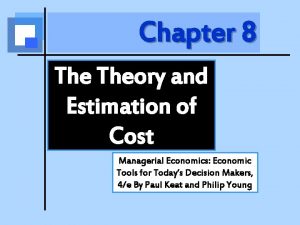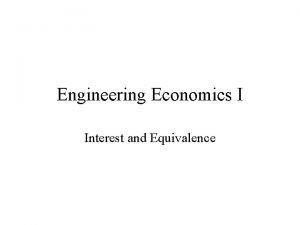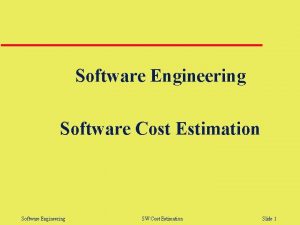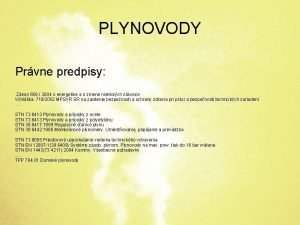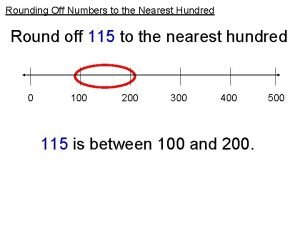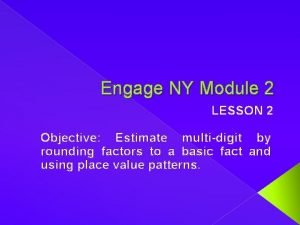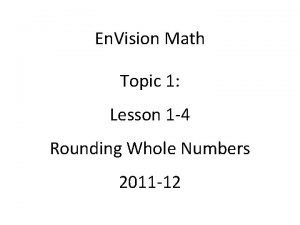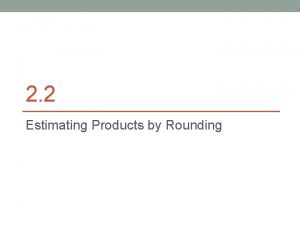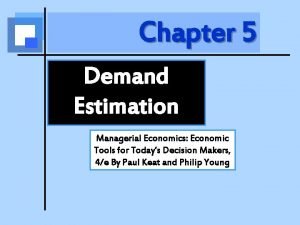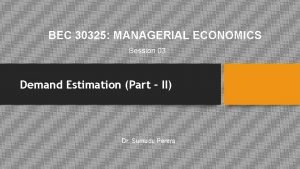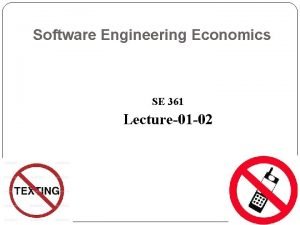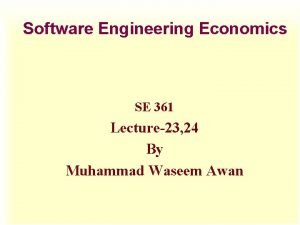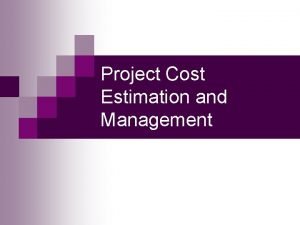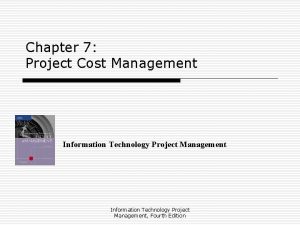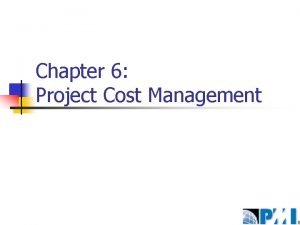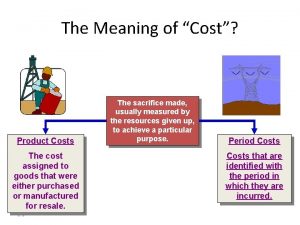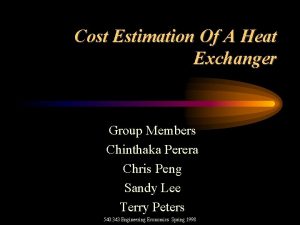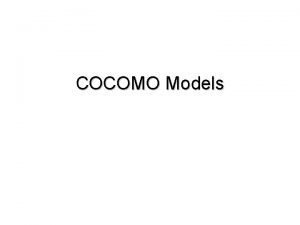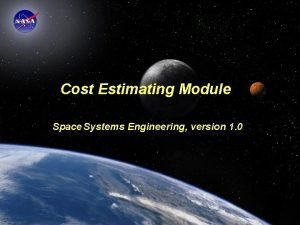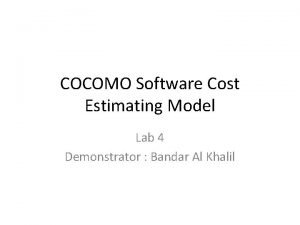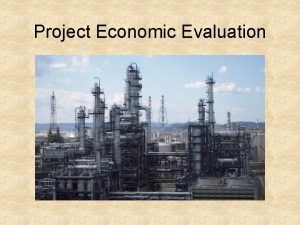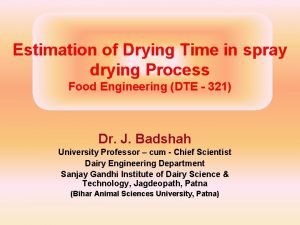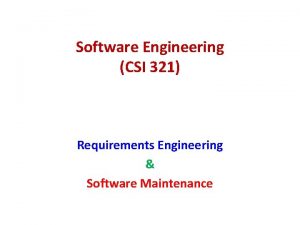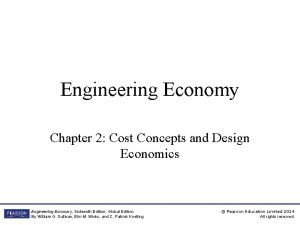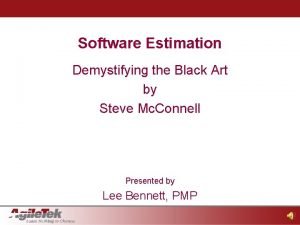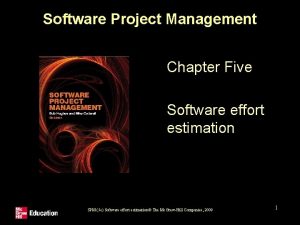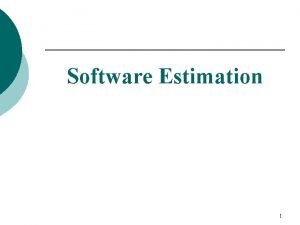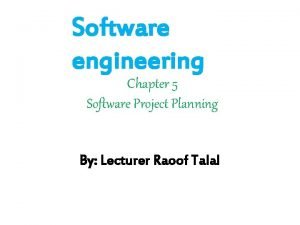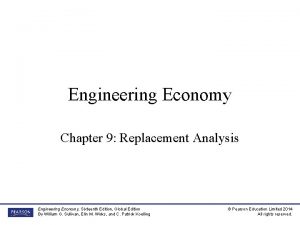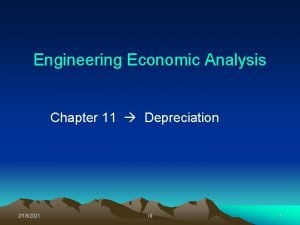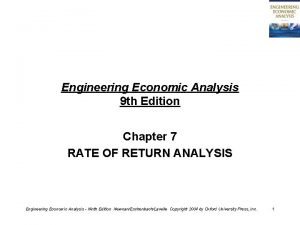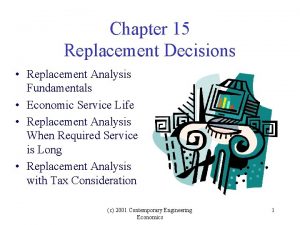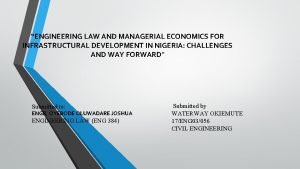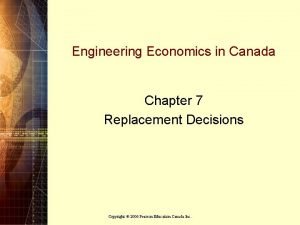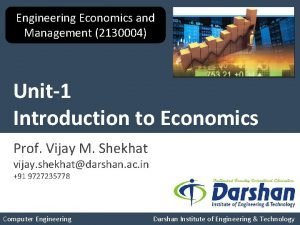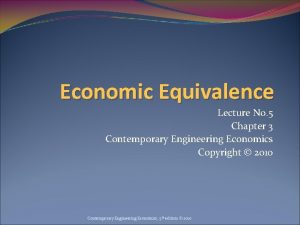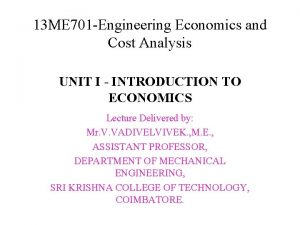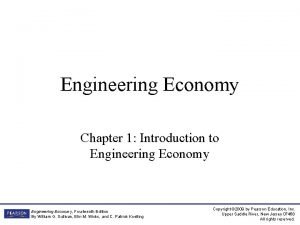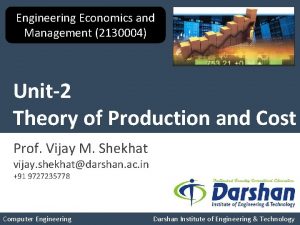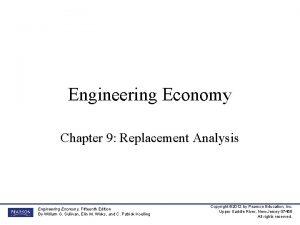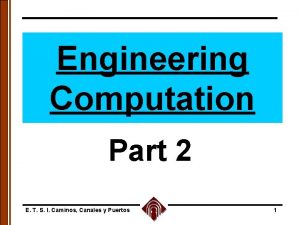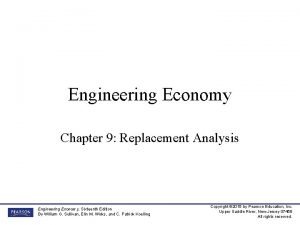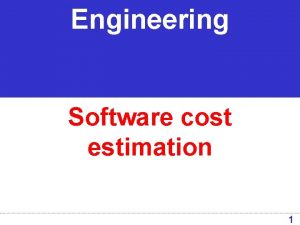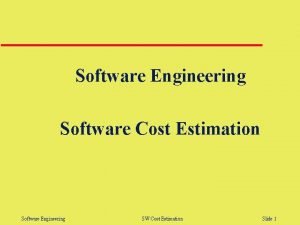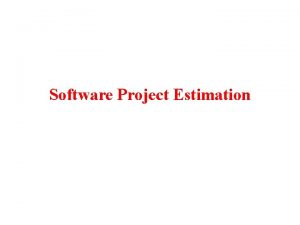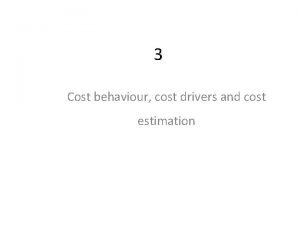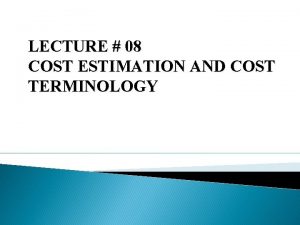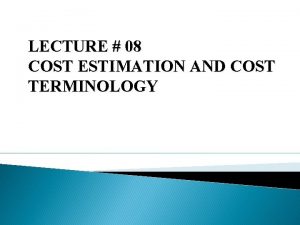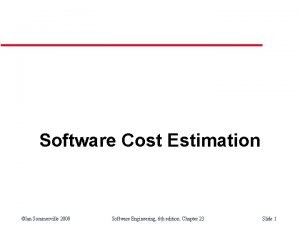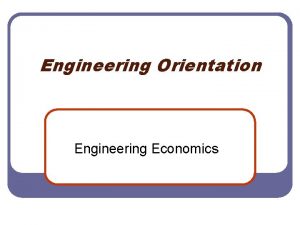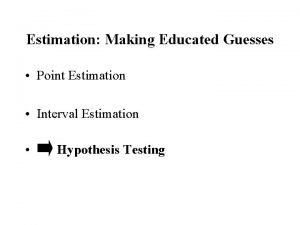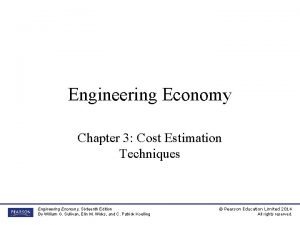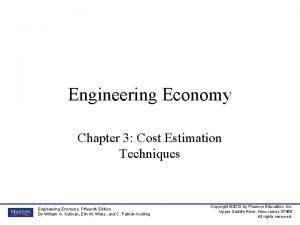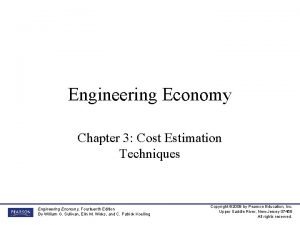Software Engineering Economics CS 656 Software Cost Estimation











![WHO SANG COCOMO? • The Beach Boys [1988] Aruba, Jamaica, ooo I wanna take WHO SANG COCOMO? • The Beach Boys [1988] Aruba, Jamaica, ooo I wanna take](https://slidetodoc.com/presentation_image_h2/b79d50aa2534c4e0eff993d21b178d21/image-12.jpg)






















































- Slides: 66

Software Engineering Economics (CS 656) Software Cost Estimation w/ COCOMO II Jongmoon Baik

Software Cost Estimation

“You can not control what you can not see” - Tom Demarco - 3

Why Estimate Software? • 30% of project never complete • 100 -200% cost overruns not uncommon • Average project exceeds cost by 90%; Schedule by 120% • 15% of large project never deliver anything • Only 16. 2% of projects are successful * 1998, 1999, 2000 Standish report, Choas 4

When to Estimate? • Estimation during the Bid – Short duration, fastest possible, least understanding • Estimation at project Start – Creating full plan, allocating resources, detailed estimation • Estimation during the project – How do you handle change 5

Why are we bad at estimating? • Complexity of the systems – Infrequency - How often do we do the “same thing” • vs. manufacturing or construction – Underestimation bias • Computers are “easy”; software is “easy” – We deal with Goals not estimates • Must be done by June – Complexity is what makes estimating hard 6

Why are we bad at estimating? (2) • Complexity of the systems – ~1000 FP in a pace maker (50 K) – ~18, 800 FP in shuttle test scaffolding (1, 000 LOC) – ~75, 400 FP in Nynex Switch (4, 000 LOC) • “Human brain capacity is more or less fixed, but software complexity grows at least as fast as the square of the size of the project” Tony Bowden 7

Determining “Development effort” • Development effort measures – – Person-Month LOC per Hour Function point per hour Requirement per hour • Most common is person-months (or hours) • We will look at ways to get development effort 8

Why Is It Important? ? • Software cost is big and growing • Many useful software products are not getting developed • Get us better software not just more software Boehm et. Al, “Understanding and Controlling Software Cost”, IEEE TSE, SE 4, 10, pp 1462 -77 9

Software Estimation Techniques 10

Software Cost Estimation Steps 1. Establish Objectives – – – 2. 3. Allocate Enough Time, Dollars, Talent Pin down Software Requirements – 4. 5. Top-Down vs. Bottom-Up Algorithm Vs. Expert-Judgement Compare and iterate estimates – – 7. Documents Definition, Assumption Work out as much detail as Objectives permit Use several independent Techniques + Sources – – 6. Rough Sizing Make-or-Buy Detailed Planning Pin down and resolve inconsistencies Be Conservative Follow up 11
![WHO SANG COCOMO The Beach Boys 1988 Aruba Jamaica ooo I wanna take WHO SANG COCOMO? • The Beach Boys [1988] Aruba, Jamaica, ooo I wanna take](https://slidetodoc.com/presentation_image_h2/b79d50aa2534c4e0eff993d21b178d21/image-12.jpg)
WHO SANG COCOMO? • The Beach Boys [1988] Aruba, Jamaica, ooo I wanna take you • “Ko. Mo” To Bermuda, Bahama, come on, pretty mama Key Largo, Montego, baby why don't we go jamaica Off the Florida Keys there's a place called Kokomo That's where you want to go to get away from it all Bodies in the sand Tropical drink melting in your hand We'll be falling in love to the rhythm of a steel drum band Down in Kokomo …………. . ……………. . 12

Who are COCOMO? KBS 2 – “an exploration party to challenge the globe” Sep. 4, 2005 A tribe in Kenya 13

What is COCOMO? “COCOMO (COnstructive COst MOdel) is a model designed by Barry Boehm to give an estimate of the number of programmermonths it will take to develop a software product. ” 14

COCOMO II Overview - I Software development, maintenance cost and schedule estimates Software product size estimate Software product, process, computer, and personnel attributes Software reuse, maintenance, and increment parameters Software organization’s project data COCOMO II Cost, schedule distribution by phase, activity, increment COCOMO recalibrated to organization’s data 15

COCOMO II Overview - II • Open interfaces and internals – Published in Software Cost Estimation with COCOMO II, Boehm et. al. , 2000 • COCOMO – Software Engineering Economics , Boehm, 1981 • Numerous Implementation, Calibrations, Extensions – Incremental Development, Ada, new environment technology – Arguably the most frequently-used software cost model worldwide 16

List of COCOMO II Packages • • • USC COCOMO II. 2000 - USC Costar – Softstar Systems ESTIMATE PROFESSIONAL – SPC Cost. Xpert – Marotz Partial List of COCOMO Packages (STSC, 1993) – CB COCOMO, GECOMO Plus, COCOMOID, GHL COCOMO, COCOMO 1, REVIC, Co. Pro, SECOMO, COSTAR, SWAN, COSTMODL 17

COCOMO II User Objectives • Making investment or other financial decisions involving a software development • Setting project budgets and schedules as a basis for planning and control • Deciding on or negotiating tradeoffs among software cost, schedule, functionality, performance or quality factors • Making software cost and schedule risk management decisions • Deciding which parts of a software system to develop, reuse, lease or purchase • Making legacy software inventory decisions: what parts to modify, phase out, outsource, etc. • Setting mixed investment strategies to improve your organization’s software capability, via reuse, tools, process maturity, outsourcing, etc. • Deciding how to implement a process improvement strategy 18

COCOMO II Objectives • Provide accurate cost and schedule estimates for both current and likely future software projects. • Enabling organizations to easily recalibrate, tailor or extend COCOMO II to better fit their unique situations. • Provide careful, easy-to-understand definition of the model’s inputs, outputs and assumptions. • Provide constructive model. • Provide a normative model. • Provide evolving model. 19

• COCOMO II Evolution Strategies I Proceed incrementally – Estimation issues of most importance and tractability w. r. t modeling, data collection, and calibration. • Test the models and their concepts on first-hand experience – Use COCOMO II in annual series of USC Digital Library projects • Establish a COCOMO II Affiliates’ program – Enabling us to draw on the prioritized needs, expertise, and calibration data of leading software organizations 20

COCOMO II Evolution Strategies - II • Provide an externally and internally open model. • Avoid unnecessary incompatibilities with COCOMO 81. • Experiment with a number of model extensions. • Balanced expert- and data- determined modeling. • Develop a sequence of increasingly accurate models. • Key the COCOMO II models to projections of future software life cycle practices. 21

S/W Estimation Accuracy vs. Phase 4 x Completed Programs 2 x + 1. 5 x Relative Size Range + + x USAF/ESD Proposals + + + 1. 25 x Size (DSI) + Cost ($) + + + 0. 5 x Concept of Operation 0. 25 x Feasibility “Corn of Software Cost Estimation” Plans and Rqts. Product Design Spec. Rqts. Spec. Product Design Phases and Milestones Detail Design Spec. Detail Design Accepted Software Devel. and Test 22

MBASE/Rational Anchor Point Milestones App. Compos. Inception LCO, LCA Sys Devel Waterfall Rqts. SRR Inception Phase LCO Transition Elaboration, Construction IOC SAT PDR Prod. Des. Development Elaboration Construction LCA Trans. IOC 23

Application Composition Model • Challenge: – Modeling rapid application composition with graphical user interface (GUI) builders, clientserver support, object-libraries, etc. • Responses: – Application-Point Sizing and Costing Model – Reporting estimate ranges rather than point estimate 24

Application Point Estimation Procedure Step 1: Assess Element-Counts: estimate the number of screens, reports, and 3 GL components that will comprise this application. Assume the standard definitions of these elements in your ICASE environment. Step 2: Classify each element instance into simple, medium and difficult complexity levels depending on values of characteristic dimensions. Use the following scheme: Step 3: Weigh the number in each cell using the following scheme. The weights reflect the relative effort required to implement an instance of that complexity level. Element Type Screen Report 3 GL Component Simple 1 2 Complexity-Weight Medium Difficult 2 3 5 8 10 Step 4: Determine Application-Points: add all the weighted element instances to get one number, the Application-Point count. Step 5: Estimate percentage of reuse you expect to be achieved in this project. Compute the New Application Points to be developed NAP =(Application-Points) (100 -%reuse) / 100. Step 6: Determine a productivity rate, PROD=NAP/person-month, from the following scheme: Step 7: Compute the estimated person-months: PM=NAP/PROD. 25

Sizing Methods • Source Lines of Code (SLOC) – SEI Definition Check List • Unadjusted Function Points (UFP) – IFPUG 26

Source Lines of Code • Best Source : Historical data form previous projects • Expert-Judged Lines of Code • Expressed in thousands of source lines of code (KSLOC) • Difficult Definition – Different Languages • COCOMO II uses Logical Source Statement – SEI Source Lines of Code Check List – Excludes COTS, GFS, other products, language support libraries and operating systems, or other commercial libraries 27

SEI Source Lines of Code Checklist 28

Unadjusted Function Points - I • Based on the amount of functionality in a software project and a set of individual project factors. • Useful since they are based on information that is available early in the project life-cycle. • Measure a software project by quantifying the information processing functionality associated with major external data or control input, output, or file types. 29

Unadjusted Function Points - II Step 1. Determine function counts by type. The unadjusted function point counts should be counted by a lead technical person based on information in the software requirements and design documents. The number of each the five user function types should be counted (Internal Logical File (ILF), External Interface File (EIF), External Input (EI), External Output (EO), and External Inquiry (EQ)). Step 2. Determine complexity-level function counts. Classify each function count into Low, Average, and High complexity levels depending on the number of data element types contained and the number of file types reference. Use the following scheme. Step 3. Apply complexity weights. Weight the number in each cell using the following scheme. The weight reflect the relative value of the function to the user. Step 4. Compute Unadjusted Function Points. Add all the weight functions counts to get one number, the Unadjusted Function Points. 30

Relating UFPs to SLOC • USC-COCOMO II – Use conversion table (Backfiring) to convert UFPS into equivalent SLOC – Support 41 implementation languages and USR 1 -5 for accommodation of user’s additional implementation languages – Additional Ratios and Updates : http: //www. spr. com/library/0 Langtbl. htm 31

Exercise - I • Suppose you are developing a stand-alone application composed of 2 modules for a client – Module 1 written in C • FP multiplier C 128 – Module 2 written in C++ • FP multiplier C++ 53 • Determine UFP’s and equivalent SLOC 32

Information on Two Modules FP default weight values Module 1 Module 2 33

Early Design & Post-Architecture Models A = 2. 94 B = 0. 91 C = 3. 67 D = 0. 28 • Early Design Model [6 EMs]: • Post Architecture Model [16 EMs]: *Exclude SCED driver EMs: Effort multipliers to reflect characteristics of particular software under development A : Multiplicative calibration variable E : Captures relative (Economies/Diseconomies of scale) SF: Scale Factors 34

Scale Factors & Cost Drivers • Project Level – 5 Scale Factors – Used for both ED & PA models • Early Design – 7 Cost Drivers • Post Architecture – 17 Cost Drivers – Product, Platform, Personnel, Project 35

Project Scale Factors - I • Relative economies or diseconomies of scale – E < 1. 0 : economies of scale • Productivity increase as the project size increase • Achieved via project specific tools (e. g. , simulation, testbed) – E = 1. 0 : balance • Linear model : often used for cost estimation of small projects – E > 1. 0 : diseconomies of scale • Main factors : growth of interpersonal communication overhead and growth of large-system overhead 36

Project Scale Factors - II 37

PMAT == EPML • EPML (Equivalent Process Maturity Level) 38

PA Model – Product EMs 39

PA Model - CPLX 40

PA Model – Platform EMs 41

PA Model – Personnel EMs 42

PA Model – Project EMs 43

ED EMs vs. PA EMs 44

ED Model EMs - RCPX 45

ED Model EMs - PDIF 46

ED Model EMs - PERS 47

ED Model EMs - PREX 48

ED Model EMs - FCIL 49

Calibration & Prediction Accuracy COCOMO Calibration MRE: PRED (. 30) Values 50

COCOMO II Family 51

COCOMO Model Comparison 52

USC-COCOMO II. 2000 Demo. 53

Reuse & Product Line Mgmt. • Challenges - Estimate costs of both reusing software and developing software for future reuse - Estimate extra effects on schedule (if any) • Responses - New nonlinear reuse model for effective size - Cost of developing reusable software estimated by RUSE effort multiplier - Gathering schedule data 54

Non-Linear Reuse Effect 55

Primary Cost Factors for Reuse (NASA) • Cost of Understanding – 47% of the effort in SW maintenance involves understanding the SW to be modified [Parikh-Zvegintzov 1983] • Relative cost of Checking Module Interfaces – Relation b/w no. of modified modules and no. of module interface checking [Gerlich-Denskat 1994] N: number of module interface checks required m: number of modules for reuse k: number of modules modified 56

COCOMO II Reuse Model • Add Assessment & Assimilation increment (AA) – - Similar to conversion planning increment • Add software understanding increment (SU) – – – To cover nonlinear software understanding effects Coupled with software unfamiliarity level (UNFM) Apply only if reused software is modified 57

Software Understanding 58

Assessment and Assimilation (AA) 59

Unfamiliarity (UNFM) 60

Guidelines for Quantifying Adapted Software 61

Requirement Evolution & Volatility (REVL) • Adjust the effective size of the product – Causal factors: user interface evolution, technology upgrades, or COTS volatility • Percentage of code discarded due to requirement evolution – E. g. , SLOC = 100 K and REVL = 20 • Project effective size = 120 K 62

Example: Manufacturing Control System • Reused Code: 100 SLOC • Full Cost: 2. 94(100)1. 10 (1. 18) ($8 K/PM) = $4400 K • International Factory Reuse: halfway between VH and XH • Recommended Reliability rating: 1 level lower • Recommended Documentation rating: High • Develop for Reuse: $4400 (1. 195)(1. 18)(1. 11) = $6824 K 63

Subsequent Development w/ Reuse – – – – – Black-box plug-and-play: 30 KSLOC Reuse with modifications: 30 KSLOC New factory-specific SW: 40 KSLOC Assessment and assimilation (AA): 2% Software understanding factor (SU): 10% Unfamiliarity factor (UNFM): 0. 3 % design modified (DM): 10% % code modified (CM): 20% % integration modified (IM): 20% AAF =. 4(10) +. 3 (20) =. 16 100 – ESLOC = 40 + (30) (. 02) + (30) (. 02 + (. 3) (. 1) +. 16) – = 40 + 0. 6 + 6. 3 = 46. 9 – COST = 2. 94 (46. 9)1. 10 (1. 18) (1. 195) (1. 18) (1. 1) ($8 K) = $2966 K 64

Reuse vs. Redevelopment 65

Q&A 66
 Cost theory and estimation in managerial economics
Cost theory and estimation in managerial economics Estimation of cost function in managerial economics
Estimation of cost function in managerial economics Project cost management lecture notes
Project cost management lecture notes Capitalized cost formula engineering economics
Capitalized cost formula engineering economics Economic engineering formulas
Economic engineering formulas Cost of software engineering
Cost of software engineering 656 hesap
656 hesap Bio 656
Bio 656 656/2004
656/2004 650 to the nearest 100
650 to the nearest 100 My homework lesson 2 round to estimate products
My homework lesson 2 round to estimate products Round 160 656 to the nearest hundred thousand
Round 160 656 to the nearest hundred thousand Round the factors to estimate the products
Round the factors to estimate the products Demand forecasting managerial economics
Demand forecasting managerial economics What is demand estimation in managerial economics
What is demand estimation in managerial economics Demand estimation in managerial economics
Demand estimation in managerial economics Software engineering economics
Software engineering economics Software engineering economics
Software engineering economics Objectives of cost estimation
Objectives of cost estimation Surveyor pro project cost estimate
Surveyor pro project cost estimate Objectives of cost management
Objectives of cost management Product cost estimation
Product cost estimation Shell and tube heat exchanger cost estimation
Shell and tube heat exchanger cost estimation Project size
Project size Satellite cost estimation
Satellite cost estimation Cocomo cost estimation model
Cocomo cost estimation model Structural steel fabrication cost estimation xls
Structural steel fabrication cost estimation xls Cost estimation
Cost estimation Spray dryer cost estimation
Spray dryer cost estimation Adaptive maintenance in software engineering
Adaptive maintenance in software engineering Electrical conduit installation estimating
Electrical conduit installation estimating Peer inspections a pragmatic view
Peer inspections a pragmatic view Maastricht university economics and business economics
Maastricht university economics and business economics Mathematical economics vs non mathematical economics
Mathematical economics vs non mathematical economics What is system in software engineering
What is system in software engineering Forward engineering in software engineering
Forward engineering in software engineering Cost in economics
Cost in economics Engineering economy 16th edition chapter 2 solutions
Engineering economy 16th edition chapter 2 solutions Software estimation demystifying the black art
Software estimation demystifying the black art Software effort estimation in spm
Software effort estimation in spm Software estimation demystifying the black art
Software estimation demystifying the black art What is first activity in software project planning
What is first activity in software project planning Software maintenance in software engineering ppt
Software maintenance in software engineering ppt What is software implementation in software engineering
What is software implementation in software engineering Metrics computer science
Metrics computer science Software engineering crisis
Software engineering crisis What is software measurement
What is software measurement Real time software design in software engineering
Real time software design in software engineering Software design fundamentals in software engineering
Software design fundamentals in software engineering Replacement analysis in engineering economics
Replacement analysis in engineering economics Soyd depreciation
Soyd depreciation Euac engineering economics
Euac engineering economics Replacement analysis in engineering economics
Replacement analysis in engineering economics How managerial economics is useful to engineers
How managerial economics is useful to engineers Replacement analysis in engineering economics
Replacement analysis in engineering economics Introduction to engineering economics
Introduction to engineering economics Engineering economics vtu notes
Engineering economics vtu notes Equivalence in economics
Equivalence in economics Scope of engineering economics
Scope of engineering economics Engineering economy problems
Engineering economy problems Law of variable proportions in economics
Law of variable proportions in economics Engineering economics
Engineering economics Replacement studies engineering economics
Replacement studies engineering economics Engineering economics formulas
Engineering economics formulas Replacement analysis in engineering economics
Replacement analysis in engineering economics Cost accumulation and cost assignment
Cost accumulation and cost assignment Cost accumulation and cost assignment
Cost accumulation and cost assignment

